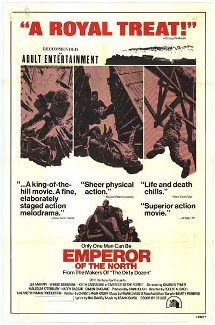
EMPEROR OF THE NORTH
US, 1973, 118 minutes, Colour.
Lee Marvin, Ernest Borgnine, Keith Carradine.
Directed by Robert Aldrich.
Emperor of the North is an unusual film. It may be one of those films that are better to think about afterwards than to see. It takes up the Depression themes so prevalent in recent films, even in Robert Aldrich's own preceding film, The Grissom Gang. Instead of showing us a gang at work, involved in crime to attain some glory and to survive in a poor society and an unjust one, it shows us train-riders.
However, the hero and villain of the film are not too far distant from the Bonnies and Clydes, the Dillingers and the Pretty Boy Floyds. Lee Marvin is A Number 1, the king of the railroads, the men who survive by scrounging a living from the land and travel around it at no expense on the trains. A Number 1 is like the king of the kids in a school and there is an atmosphere of cheeky larrikinism about these men who survive in this way. Their defiance of the rail men, who also want to be Number 1 on the trains, takes on the nature of the war between teachers and pupils or parents and children. This gives this particular depression story a different flavour and an added interest. The film is violent, but so were these stories in the 30's.
Lee Marvin and Ernest Borgnine had worked with Aldrich for The Dirty Dozen. In fact, most of Aldrich's films have a toughness about them and a strong masculinity: Ulzana's Raid, The Flight of the Phoenix. His films, however, also have a strange and unusual approach to women, for instance - Whatever Happened to Baby Jane, Hush, Hush, Sweet Charlotte, The Legend of Lylah Clare, The Killing of Sister George.
1. The meaning and overtones of the title as explained within the film?
2. How well did the film visually present the Depression period? The life and work of the hobos? The colonies? The train rides? The look of the sets and the clothes of the time? How did this create an atmosphere for the theme of the film? How successfully?
3. What was the nature of the enclosed world of the hoboes? With their own language and signs and traditions? How was it reminiscent of boys in a school truing to be cheeky and defiant? Is this a good analogy for understanding these men? Does it explain their behaviour, their values, standards, violence?
4. How were these men victims of American and Depression society? Was it their own fault? Did they have any alternative? Is this the only way in which they could survive?
5. What was the result on personalities of this kind of pressure from society and circumstances? Consider the colonies of the hoboes? Their spirit amongst themselves? Their hero in A Number 1.
6. How did A Number 1 fit into this context? Why was he hero and an emperor? Comment on how the film presented his skills? His shrewdness? His attitudes of like and hate? How mature was he in his attitudes and how much an adolescent?
7. How was Shack a villain? What made him as he was? Why was he full of hatred? Why did he hate the hoboes? How much pride did he have in his railway work? Why did he respond so viciously to their tricks? Was the effect on their rerouting trains and spoiling his timetables? Why was he so fierce?
8. Cigarette - why was he aiming to be A Number 1? Was he too cocksure of himself? Would he have had any chance of being a successor to A Number 1? Why did he not learn by his mistakes? What did he learn from A Number 1? Why was he so unlikeable and mean?
9. What was the aim and purpose of making this film? How was this illustrated in various incidents? With a visual presentation of the settings? The showing off of the various groups, the railway men and their reactions to Shack, their support of the hoboes, the re-routing of the train, the torture incidents with Shack and A Number 1 and Cigarette under the train, etc.. Shack pushing people off the train and the fights on the train, A Number 1 and Cigarette in the slag and garbage heaps etc?
10. How violent a film was this? Was it too grim? Did it exploit violence? Would it treat violence as a theme and try to draw meaning from it? What did the film have to communicate about physical pain and endurance? Especially with the chain bar method under the train? The final fight between Shack and A Number 1. How ugly was this? How necessary for the film? Where were your sympathies? Why?
11. Did the makers of the film intend this to be a kind of parable? With A Number 1 as an oppressed kind of hero? With Shack as a derelict villain to be combated? If so, was it successful in communicating this? (Did the title have overtones of this mythic quality?).